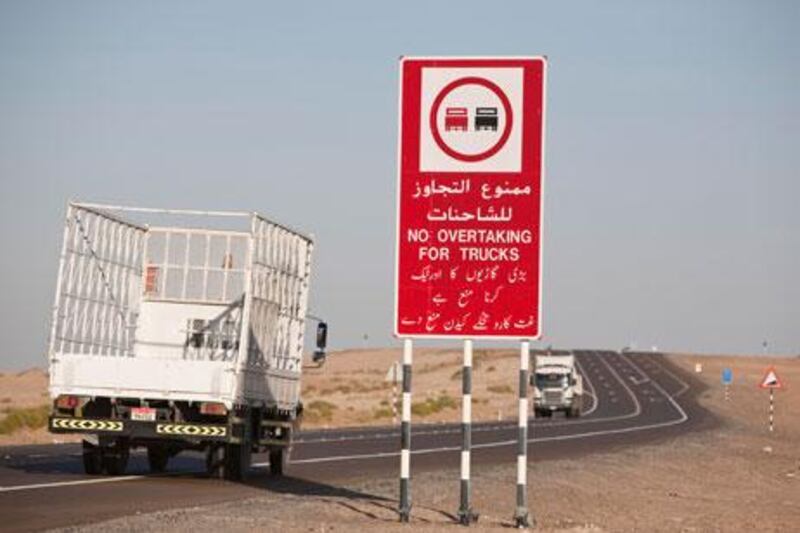ABU DHABI // The speed limit is 80kph, but no one seems to care.
To overtake lorries, impatient car drivers swing out into the lane for oncoming traffic, with no barriers between the carriageways to stop them.
Any vehicle approaching head-on is often invisible because of the high sand dunes that turn every hilltop into a deadly game of Russian roulette.
As cars race past them, lorry drivers move over to the hard shoulder – if they can see it, because lane markings are rare.
Slower moving cars shake as lorries whizz past them, missing by only a couple of inches.
This is the eery, uninviting and nerve-wracking E30 Abu Dhabi-Al Ain truck road, where 24 people died in a horrific lorry and bus crash on Monday.
The surprise is not that this fatal accident happened. The surprise, on this deadly road, is that such a tragedy has not happened before.
Monday’s crash is thought to have been the deadliest on the nation’s roads.
A lorry ploughed into the back of a bus carrying 45 maintenance workers about 35 kilometres from Al Ain, next to Al Rawda Palace. It overturned on top of the bus, leaving the victims suffocating under its 75-tonne load of sand and building material.
Police say the lorry was travelling too close behind the bus, and when the bus slowed to turn left into the palace, the lorry’s brakes failed.
It is difficult to avoid the conclusion that this road is an accident waiting to happen.
Not only are the sides of the old truck road not protected by any barriers, but a large part of it lacks any kind of lane marking, making it virtually impossible to discern which lane to stick to.
Whenever drivers are lucky enough to have road signs, a large chunk of them are displayed only in Arabic.
Bulky pieces of gravel are often blown into the middle of the road, while random holes in the ground surprise drivers every now and again, causing them to skid sideways.
Drivers are obliged to keep their eyes glued to the road, as lorries are constantly overtaking other vehicles at wild speeds.
The dark orange sand hugging the sides of the road is the only "safety net" for anyone who might be forced to veer off to avoid an incoming vehicle.
On some parts of the road, three lanes are suddenly reduced to a narrow single carriageway, meaning drivers have to trust each other to judge their speed and direction absolutely accurately.
The occasional pedestrian can be seen strolling along the side of the road, taking his life in his hands and hoping to hitch a lift with one of the vehicles racing along the highway.
And every now and then there are telltale black skid-marks zigzagging across the surface, evidence that the road is no stranger to accidents and near misses.
As the sun starts to set, darkness takes over with almost no road lights in sight. All that can be distinguished are the lorries’ large headlights, moving at an alarmingly high speed.
Only a couple of the road’s roundabouts are illuminated, before drivers find themselves thrust back into pitch-black darkness.
This is not a road for the faint-hearted.






